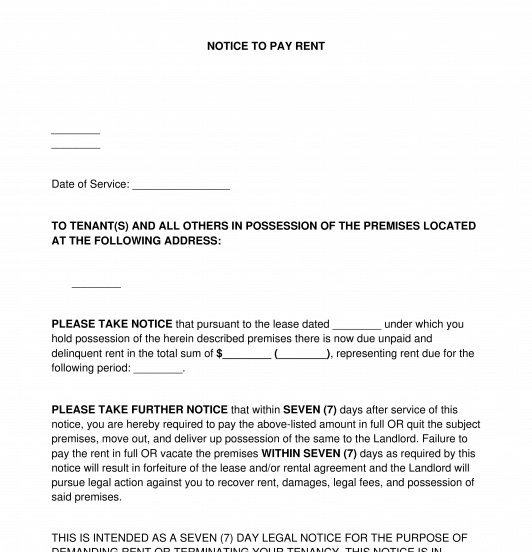 01/02/2024
01/02/2024

Answer a few questions and your document is created automatically.

Your document is ready! You will receive it in Word and PDF formats. You will be able to modify it.




Rating: 4.8 - 179 votes
Fill out the templateAn Eviction Notice, also known as a Notice to Quit, is a document sent by a Landlord to a Tenant to inform them of a violation or termination of the lease agreement and to start the process of removing a Tenant from the property. This process can be very technical and varies from state to state. However, this eviction process generally begins with the Landlord providing the Tenant with a written Eviction Notice. Acceptable reasons to evict a tenant range from issues such as nonpayment of rent, violation of the lease terms, engaging in illegal activities on the premises, ending a month to month lease, or a Tenant staying on the premises after the lease has been terminated. The Eviction Notice serves to make the Tenant aware that they have not complied with the terms of the lease or are otherwise subject to being evicted and gives the Tenant a deadline by which they must either correct the issue or make arrangements to leave the property. If the Tenant does not cure the violation or leave the property, the Landlord can proceed with further legal action to reclaim the property according to the process dictated by relevant state law.
How to use this document
Use this document to inform a Tenant that they have violated their lease or their lease agreement is otherwise being terminated prior to the Landlord filing an eviction action in court. This Notice includes important facts about the property and lease agreement, including the parties to the lease, address of the rental property, the date the Tenant entered into the lease agreement, a description of the reason why the Tenant is being evicted, and, if applicable, instructions about how the Tenant can cure the lease violation and the deadline by which they must take action to cure their violation and come in compliance with the lease.
Once the Landlord has completed the Eviction Notice, it is generally accepted practice for them to sign and date it and make arrangements to provide the Tenant with the Notice, being sure to keep a copy of the Notice for their own files in case of future legal action. Generally, an Eviction Notice is sent by certified mail or delivered in person, so as to create a record that the letter was sent and received by the Tenant. This record may be useful in case of future legal action, such as filing for eviction in court. All states require that a Tenant receive an eviction notice informing them of their eviction prior to the Landlord filing in court, so this record is essential to successfully completing the eviction process.
Applicable law
As with all landlord/tenant law, the laws that dictate an Eviction Notice and the eviction procedure are highly state specific. Depending on the state, the Landlord is limited to a particular list of acceptable reasons to evict a Tenant. Further, depending on both the state and the reason for the eviction, Tenants have varying amounts of time to either cure the violation or make arrangements to leave the property prior to the Landlord instituting an eviction action in court. In states that have rent control laws, the process is further complicated if the property in question is rent controlled. To ensure that the Landlord is complying with state and local laws in beginning the eviction process, Landlords can get more information from their state or city housing bureau, municipal court, or local landlord or tenants union. This document is customized to reflect the laws of each state, depending on the state the user selects.
How to modify the template
You fill out a form. The document is created before your eyes as you respond to the questions.
At the end, you receive it in Word and PDF formats. You can modify it and reuse it.
Guides to help you
Other names for the document:
Notice to Pay Rent or Quit, Notice to Quit, Notice to Terminate Tenancy, Notice to Cure or Vacate, Notice to Comply with Rental Agreement
Country: United States